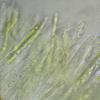
16-01-2026 00:45
Ethan CrensonHi all, On decorticated hardwood from a New York

10-01-2026 20:00
Tom SchrierHi all,We found picnidia on Protoparmeliopsis mur

13-01-2026 07:28
 Danny Newman
Danny Newman
Chlorociboria glauca on indet. decorticate logThe

08-12-2025 17:37
 Lothar Krieglsteiner
Lothar Krieglsteiner
20.6.25, on branch of Abies infected and thickened

15-01-2026 15:55
 Lothar Krieglsteiner
Lothar Krieglsteiner
this one is especially interesting for me because

13-01-2026 08:43
 Danny Newman
Danny Newman
Tricladium varicosporioides on indet. decorticate

07-01-2026 22:22
 Danny Newman
Danny Newman
Tatraea sp. on indet. hardwood The Swag, Great Sm

13-01-2026 09:10
 Danny Newman
Danny Newman
Dasyscyphella chrysotexta on indet. decorticate ha

13-01-2026 10:13
 Danny Newman
Danny Newman
Cordieritidaceae sp. on indet. wood w/ Hypoxylon s
 Greetings AscoFrance!
Greetings AscoFrance!Here is a curious discomycete, field IDed to Ionomidotis by Paula DeSanto on the recent Peck Foray in Watkins Glen, New York. This particular find is from a mixed, predominantly hardwood forest within the Meads Creek State Forest. When I got a look at the dried material and field photos, I saw enough resemblance to my own Ionomidotis collection from North Carolina (http://mushroomobserver.org/174774) to consider the possibility, but upon preparing the material for microscopy we noticed that KOH extractable pigments (3% solution) were conspicuously absent. Can it still be Ionomidotis without this reaction? Perhaps this is a member of some other genus in the Encoelioideae?
Ascus tips inamyloid, despite appearing somewhat bluish in the micrographs. No paraphyses observed.
Spores:
9.5-14×=2.5-4.5?m (x=12.25×3.325?m, Q= 2.44-5.2?m, Qm=3.781?m, m=20, s=1)
13.5 x 3 ; 4.5
13 x 4 ; 3.25
13 x 2.5 ; 5.2
12.5 x 3.5 ; 3.57
14 x 4 ; 3.5
13 x 3 ; 4.33
9.5 x 3 ; 3.17
12.5 x 4 ; 3.13
13 x 3.5 ; 3.71
11 x 4.5 ; 2.44
13.5 x 3 ; 4.5
13.5 x 3 ; 4.5
10.5 x 4 ; 2.65
12 x 3 ; 4
12.5 x 2.5 ; 5
12.5 x 3 ; 4.17
9.5 x 3 ; 3.17
14 x 4 ; 3.5
11.5 x 3 ; 3.83
10.5 x 3 ; 3.5
Many thanks!
-Danny N.
PS: The images are all apparently too large for the site :( Please find them on Mushroom Observer here: http://mushroomobserver.org/218595

I am reminded of a Chlorencoelia, but the two species for which I have images, C. versiformis and C. torta) have distinctly amyloid asci. The spores would fit.
I am sure that the paraphyses would be seen when squashing the hymenium. If you had pictures from fresh material the genus Chlorencoelia would show a striking feature in the paraphyses (vacuolar bodies, see attach).
Zotto

Also, I believe the fact that the bottle of Melzer's used was labelled "Melzer's Replacement" may have something to do with the lack of observed blueing. Will use a more reliable reagent for the second set of micrographs.

These vacuolar bodies are a useful character at the family level. They are rather typical for the family Cenangiaceae as we now circumscribe it, but absent from the Cordieritidaceae which inbclude many ionomidotic species.

many thanks!

